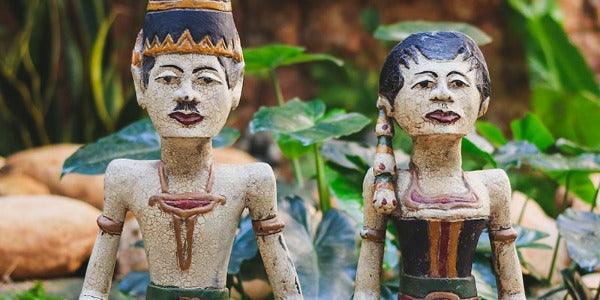The “Western” concept of art for art's sake incorporated into the history of Balinese art through Dutch influence sustains the creative freedom of artists mastering abstract sculptures carved in rustic wood. But by unveiling the historical richness and cultural particularities of the island, Balinese art finds its best artistic performance disseminating the richness of Indonesian culture in paintings on canvas , wooden statues and other works of ethnic art luxuriously handcrafted.
The very tourist incentive in Bali encourages the work of Balinese artisans who act as guides, elucidating in carved forms and artistic paintings the aspects, traditions and beliefs that constitute the history and local culture built on the island with the arrival of Chinese settlers around from 2500 BC and improved in the 14th century with the exodus of artists during the Majapahit Empire , conceiving the “Golden Age” of Balinese culture .


The daily life in the villages and the work organization of men and women in agriculture with rice paddies ( sawah ) and planting of tropical fruits (banana, coconut and cocoa) and coffee is especially portrayed in paintings on canvas , exploring the environment, the architecture, the costumes with batik or ikat and work tools to enrich the canvas spaces with color. The irrigation system used in agriculture ( subback ) is ecologically sustainable, considered a world heritage site by Unesco .
Sustainability is also maintained by local artists in the selection of reforested wood for the production of rustic furniture and handcrafted decorative statues . The latter are unique portraits of the importance of ceremonies in the lives of the Balinese present at moments such as birth, marriage and cremation accompanied by dances and music .

The people of Bali have a strong sense of community and organize themselves communally both in agriculture ( Subak ) and in traditional festivals and ceremonies ( Banjar ). Gotong royong , Dusun and Sekaa are other community organizations that help with the coordination of events, temple construction, road renovations and cleaning by bringing together economic, social and ritualistic issues that make up the uniqueness of Indonesian philosophy and life and culture.
The Balinese believe in the concept that the unity and mutual cooperation of the community will bring prosperity to it, balancing the relationship between human and environment, human and human and human and god. Therefore, when a family is formed through marriage , the man needs to join at least one Banjar whose meetings take place in its own space, the Bale Banjar - also the pavilion that hosts the gamelan orchestras .

Every Balinese participates in a series of ceremonies throughout their lives, always accompanied by offerings of flowers and fruits , called the Manusa Yadnya , which contribute to a richer and more meaningful existence. The ritualistic ceremonies take place in the first days of life and are divided into specific periods such as the 3rd and 6th month, the first menstruation for girls, akil balik for boys - as a symbol of the passage to adulthood -, marriage and cremation after the death.
A wedding in Bali is one of the most important events, symbolizing the construction of a new family, and takes place in two ways: mapadik , the more traditional one, and ngorod , marriage “by elopement”. The Balinese couple Loro Blonyo, formally attired for the mapadik ceremony or with everyday clothes glimpsing the ngorod , is a constant inspiration for the figurative art of the island's artisans, such as this duo of sculptures with a Balinese man wearing peci on his head and a Balinese woman wearing kemben on her bust next to her sarong at the bottom. Symbolically they represent the Hindu goddess Sri Devi and her consort Sadono.

It is difficult to talk about Indonesian and Balinese culture without considering the value of artistic performances for the population, also associated with ceremonies and religious beliefs such as Hinduism . Kecak and Legong Keraton are among the most relevant Balinese dances in the local culture and best known around the world; above all for the historical richness and for the art expressed in the gestures of the dancers and in the magnificence of the costumes full of details.
And to further enhance and disseminate the artistic manifestations of Bali, local artists demonstrate dexterity in mixing different particularities of Balinese culture , as expressed by this puppet wooden doll illustrating a Legong dancer with a structure inspired by wayang kulit , the traditional Balinese shadow theater with puppets .

In all Balinese art there is a perspective of the past and the ancestry of the population. In the paintings with artistic paintings or in sets of rustic wooden sculptures , also hand-painted , there is a sui generis emphasis on the woman with naked bust . These works inspired by ancient times refer to the original costumes of the “primitive” Balinese women of the “ doeloe time”, in addition to valuing the decoration with the essence of ancestral feminine beauty.
With the signature of craftsmen from Bali, the past not only continues to guide the current traditions of the archipelago, but gives a new meaning to them with interior decoration . And whatever your favorite style of visual art, you will find in the careful selection of pieces imported from the Island of Bali by Arte & Tune a way to enrich the environment with beauty and culture.
Namaste!
Milene Sousa - Art & Tune










